
Lepiota is a genus of gilled mushrooms in the family Agaricaceae. All Lepiota species are ground-dwelling saprotrophs with a preference for rich, calcareous soils. Basidiocarps are agaricoid with whitish spores, typically with scaly caps and a ring on the stipe. Around 400 species of Lepiota are currently recognized worldwide. Many species are poisonous, some lethally so.

Shaggy parasol is the common name for three closely related species of mushroom, Chlorophyllum rhacodes, C. olivieri and C. brunneum, found in North America, Europe and Southern Africa.

Echinoderma is a genus of fungi in the family Agaricaceae. Its members were for a long time considered to belong to genus Lepiota and the group was then circumscribed by French mycologist Marcel Bon in 1981 as a subgenus of Cystolepiota before he raised it to generic status in 1991.

Chlorophyllum is a genus of large agarics similar in appearance to the true parasol mushroom. Chlorophyllum was originally coined in 1898, a time when spore color was the deciding factor for differentiating genera. It was termed in order to describe the poisonous green-spored C. molybdites which shared many characteristics of the mushrooms within the genus Lepiota but lacked the all important white spores. The name derives from Greek Chloro meaning green and phyllo meaning leaf. It remained as a monotypic genus until recently when modern DNA analyses concluded that many of the mushrooms contained in the genus Macrolepiota actually had more in common genetically with the Chlorophyllum molybdites than with the other members of the Macrolepiota. The genus has a widespread distribution, with many species found in tropical regions. The best known members are the edible shaggy parasol, a name applied to three very similar species Chlorophyllum rhacodes, C. olivieri and C. brunneum, and the poisonous C. molybdites, which is widespread in subtropical regions around the world.

Lepiota brunneoincarnata, the deadly dapperling, is a gilled mushroom of the genus Lepiota in the order Agaricales. Widely distributed in Europe and temperate regions of Asia as far east as China, it grows in grassy areas such as fields, parks and gardens, and is often mistaken for edible mushrooms. The mushroom has a brown scaled cap up to 4 cm wide with a pinkish brown stem and white gills. It is highly toxic, with several deaths having been recorded as it resembles the edible grey knight and fairy ring champignon.

Macrolepiota clelandii, commonly known as the slender parasol or graceful parasol, is a species of mushroom-forming fungus in the family Agaricaceae. The species is found in Australia and New Zealand, where it fruits singly or in small groups on the ground in eucalypt woodlands, parks, and roadsides. It is a tall mushroom up to roughly 20 cm (8 in), with a broad cap covered with distinctive rings of dark brown scales. The whitish gills on the cap underside are closely spaced and free from attachment to the slender stipe, which has a loose ring on its upper half, and a bulbous base. The edibility of the mushroom is not known with certainty, but closely related parasol mushrooms are edible and some are very sought after.

Leucoagaricus is a genus of mushroom-forming fungi in the family Agaricaceae. As of March 2023 there are over 200 accepted species of Leucoagaricus with ongoing research into the genus adding several more each year. Leucocoprinus is a similar genus and considered by some sources to be indistinct from Leucoagaricus based on genetic data that demonstrates they are monophyletic. Species are separated into these genera based on macroscopic features such as cap striations in Leucocoprinus or the more persistent basidiocarps (mushrooms) of Leucoagaricus as well as microscopic features such as the lack of a germ pore in Leucoagaricus species. As a result of the similarities and disagreement on taxonomy, many of the species within these genera have formerly been classified in the other and may still be known by previous classifications. For instance the species Leucoagaricus gongylophorus is cultivated by fungus-growing ants but was formerly known as Leucocoprinus gongylophorus whilst other species cultivated by the lesser attine ants are still classified as undescribed Leucocoprinus species.
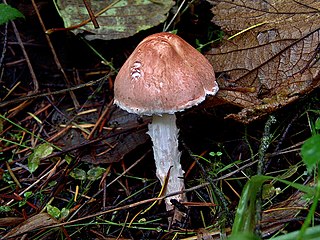
Lepiota subincarnata, commonly known as the deadly parasol, is a gilled mushroom of the genus Lepiota in the order Agaricales. It is known to contain amatoxins and consuming this fungus can be potentially lethal. The species is found in Asia, Europe, and North America, in woods as well as richly soiled parks. It was first described scientifically by the Danish mycologist Jakob Emanuel Lange in 1940. Bon and Boiffard described Lepiota josserandii in 1974, which turned out to be the same species.
Lepiota viridigleba is a species of sequestrate fungus in the family Agaricaceae. It was first described as new to science by mycologist Michael Castellano in 1995, based on collections made among Populus roots in California. The fungus was initially called Amogaster viridiglebus and tentatively placed in the order Boletales. Molecular analysis revealed the fungus to be a member of the genus Lepiota, and it was transferred to that genus in 2013.

Lepiota castaneidisca is a species of agaric fungus in the family Agaricaceae. Formally described in 1912, it was for a long time considered the same species as the similar Lepiota cristata until molecular analysis reported in 2001 demonstrated that it was genetically distinct. It is most common in coastal and northern California, and has also been recorded in Mexico. A saprobic species, it is usually found under redwood and Monterey cypress. Its fruit bodies (mushrooms) have white caps with an orange-red to orange-brown center that measure up to 3.2 cm (1.3 in) wide. The cream-colored to light pink stems are up to 6.5 cm (2.6 in) long by 0.2–0.6 cm (0.1–0.2 in) thick, and have a ring. L. castaneidisca can be distinguished from other similar Lepiota species by differences in habitat, macroscopic, or microscopic characteristics.

Lepiota cristata, commonly known as the stinking dapperling, brown-eyed parasol, or the stinking parasol, is an agaric and possibly poisonous mushroom in the family Agaricaceae. A common and widespread species—one of the most widespread fungi in the genus Lepiota—it has been reported from Europe, northern Asia, North America, and New Zealand. It fruits on the ground in disturbed areas, such as lawns, path and road edges, parks, and gardens. The species produces fruit bodies characterized by the flat, reddish-brown concentric scales on the caps, and an unpleasant odour resembling burnt rubber. Similar Lepiota species can sometimes be distinguished from L. cristata by differences in cap colour, stipe structure, or odour, although some species can only be reliably distinguished through the use of microscopy.
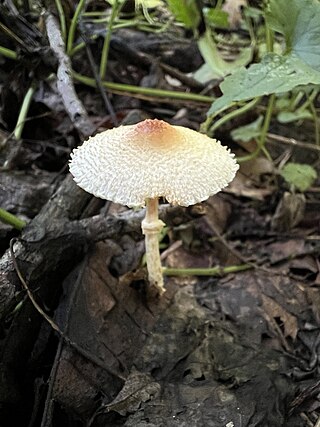
Lepiota maculans is a rare species of agaric fungus in the family Agaricaceae. It was originally collected in Missouri, and then 105 years later in eastern Tennessee. It is the only member of Lepiota known to have a pink spore print instead of the usual white or cream color. The fruit bodies have caps up to 4 cm (1.6 in) in diameter, with brownish, sparsely scaled centers. The gills are closely spaced, not attached to the stipe, and discolor reddish at the edges.

Chlorophyllum hortense is a species of agaric fungus in the family Agaricaceae.

Leucoagaricus erythrophaeus is a species of agaric fungus. Described as new to science in 2010, it is found in California, where it grows in mixed forest. The specific epithet erythrophaeus originates from the Greek words ερυ𝛉ρος and ϕαιος ("dark"), and refers to the mushroom's characteristic bruising reaction. The species was formerly known under the misapplied name Lepiota roseifolia.
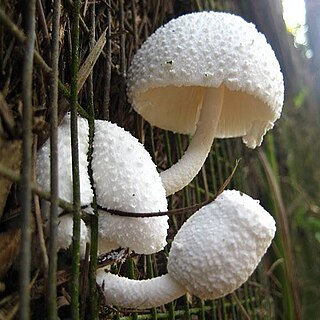
Leucocoprinus cretaceus is a species of mushroom producing fungus in the family Agaricaceae. It is likely tropical in origin although it was first documented in Europe where it was often found growing in greenhouses and bark beds. However many early observations conflate this species with Leucocoprinus birnbaumii or Leucocoprinus cepistipes despite sharing only some superficial similarities. This fungus is quite versatile even for a saprotroph and is often found growing in clusters on woodchips, sawdust and compost heaps as well as directly from the ground or on trees. It may also appear in plant pots and greenhouses in colder countries in which it is not well equipped to survive outside.
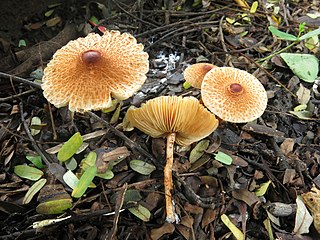
Lepiota bengalensis is a species of the fungal family Agaricaceae. It was the first generic report for Bangladesh, described as a new species to science in 2016. It is only known from Bangladesh.

Leucocoprinus ianthinus is a species of mushroom producing fungus in the family Agaricaceae. Like several other Leucocoprinus species it may have originated in a tropical climate but now finds a home in plant pots, greenhouses and compost piles in many countries. It is not seen in plant pots with the same kind of regularity as the well known Leucocoprinus birnbaumii and not seen in the wild as frequently as Leucocoprinus brebissonii.
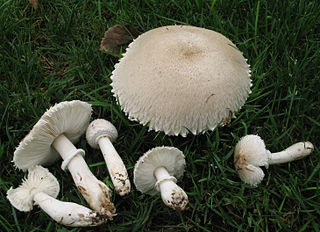
Leucoagaricus barssii, commonly known as the smoky dapperling, or gray parasol, is a species of fungus in the family Agaricaceae.

Macrolepiota zeyheri is a species of mushroom producing fungus in the family Agaricaceae. In the Kilendu dialect it is known as djilo and in the Kilur dialect it is called n'volo mighom.

















